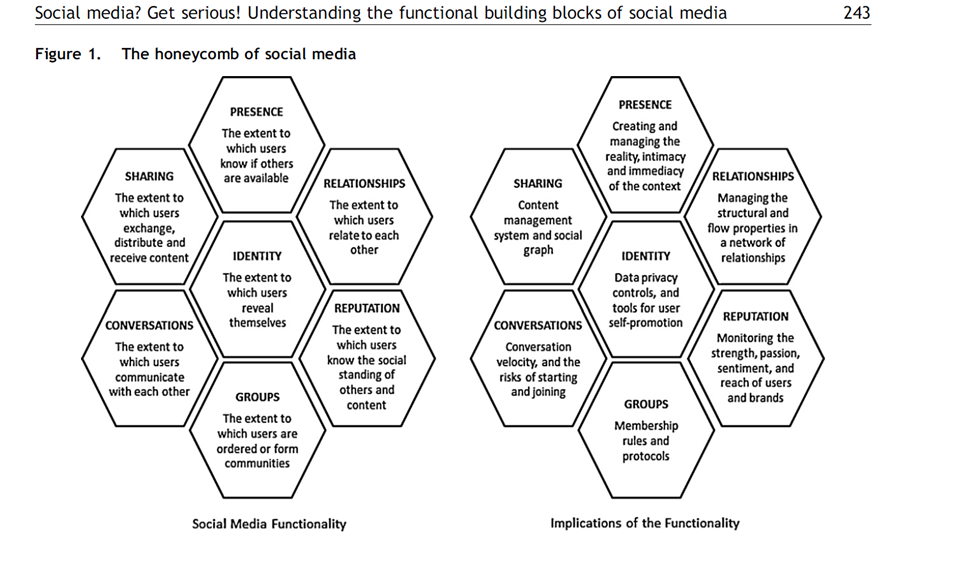General Terms
Platforms for general
masses: Facebook, Friendster, Hi5
LinkedIn:
Professional
YouTube:
Photos & Videos
Blogs:
Wide range of audience
Microblogging: Provides
real-time updates
Honeycomb of Social Media
The article provides a honeycomb framework containing seven social media building blocks to address the lack of understanding about social media and its various forms.
These blocks, when taken
individually or together, are helpful for the managers to make sense of the
social media ecology while understanding their target audience and their
engagement needs.
1. Identity: Identity
strategies could be real or virtual; some focus on self-promotion (Facebook) vs
self-branding (LinkedIn). People reveal different identities depending on the context
of different social media platforms. Maintaining a balance between sharing
identities and protecting privacy is essential in selecting social media tools.
Otherwise, the imbalance may lead to cyberbullying and off-topic and off-color
comments.
2. Conversations include
a tweet, blog, et cetera to meet new friends and find love. Firms can make
effective use of blogs by posting details that can be rich and useful to a
specific audience. However, firms need to know when they have to chime in and
show that they care for their audience.
3. Sharing represents
the extent to which users exchange, distribute, and receive content. Firms need
to identify new objects that can mediate their shared interests with the
audience, without having these shared objects, a network will be merely social connections
without anything connecting them. In addition, firms also need to be concerned
with the terms and conditions of the platform where they share the objects.
4. Presence refers
to the extent to which users know if other users are accessible in the virtual
or real-world location, such as online/hidden/available/active, check-in in a
particular place, etc. So, firms need to pay attention to the relative
importance of user availability and user location.
5. Relationships represent
the extent to which users can be related to other users. Relationships could be
formal/informal or structured/unstructured. For example, Blogs allow an
informal structure, while Skype allows people to talk to buddies or contacts
they already know. Two properties of relationships include structure and flow.
Structure refers to several connections and their position in their network
of relationships. The flow property refers to the types of resources involved
in individual relationships and how these resources are used, exchanged, or
transformed, thus describing the strength of the relationship.
6. Reputation is
the extent to which users can identify the standing of others, including
themselves, in a social media setting. For example, LinkedIn builds the reputation
of an individual based on endorsements from others. Other examples include
likes, view counts, or ratings. For a firm, the engagement needs of its
community should inform the choice of a reputation system. So, firms need to develop
a metric system to provide information on their reputation accordingly.
7. Groups represent
how users can form communities and sub-communities. Danbar (1992) mentions that
the number of stable social relationships is about 150 due to the cognitive
limit. Social media platforms provide the options of permissions and a few
categories of groups to manage many groups.
The
4 Cs
The 4 Cs relate to how
firms should develop strategies for monitoring, understanding, and responding
to social media activities.
1. Cognize:
To
navigate the social media landscape effectively, firms should utilize the
honeycomb framework, highlighting social media functionalities and customer
engagement insights. It is crucial to pinpoint where and how discussions about
the firm are happening and to comprehend the impact of key influencers in the
industry.
2. Congruity:
Firms
should develop social media strategies aligned with their goals and the
functionalities highlighted in the honeycomb framework. Key success metrics
might include the speed and engagement level of conversations. Acknowledging
the pivotal role of customer service in marketing, strategies should aim to
improve customer satisfaction and actively seek feedback.
3. Curate:
A
firm should curate its social media interactions by establishing clear engagement
frequency, timing, and representation guidelines, involving selecting employees
attentive to online discussions and skilled at creating community-appropriate
content. Policies should be developed to manage and sustain social media
engagement effectively.
4. Chase:
Continuously
monitoring social media activity can be demanding, yet it's indispensable for
firms to grasp the speed of conversations and information dissemination
influencing their market standing. Using the honeycomb framework proves
beneficial for assessing the dynamic social media environment, enabling firms
to reevaluate community engagement, track platform developments, and scrutinize
competitor reactions.
Reference: Kietzmann, J. H., Hermkens, K., McCarthy, I.
P., & Silvestre, B. S. (2011). Social media? Get serious! Understanding the
functional building blocks of social media. Business horizons, 54(3), 241-251.




Comments
Post a Comment